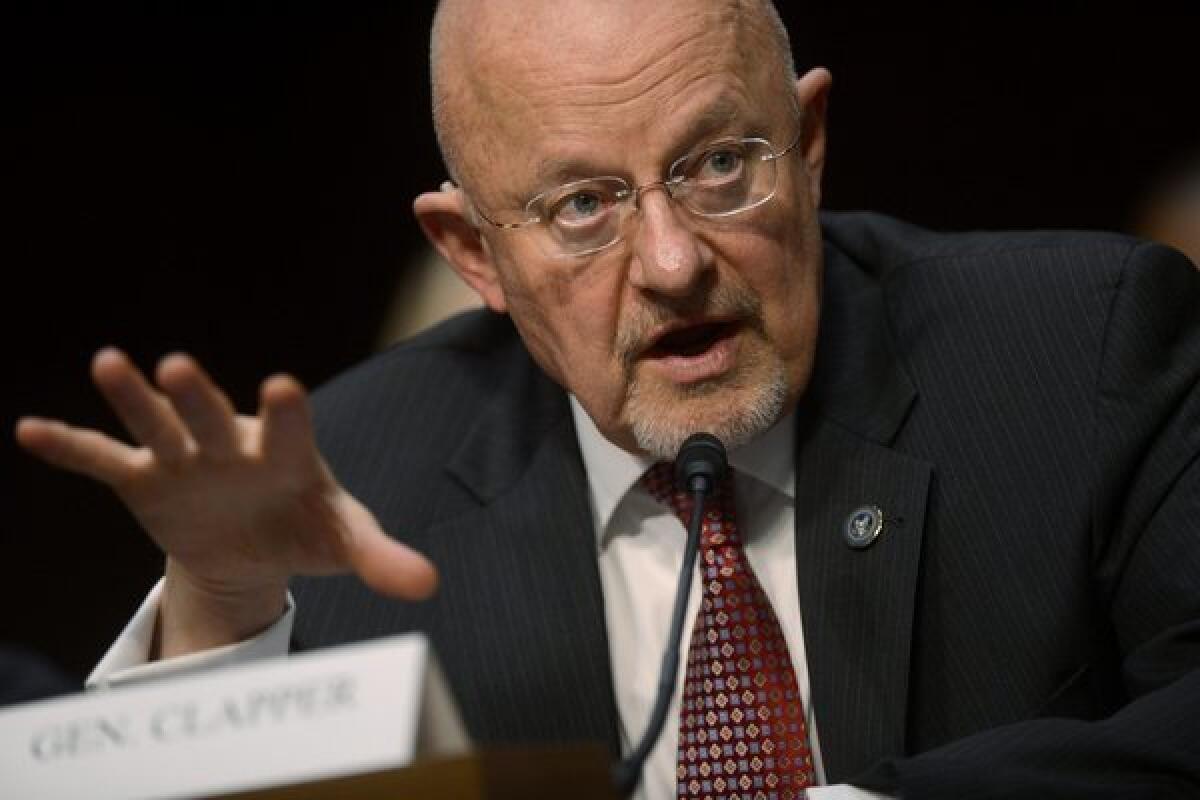Cyber-crime tops threats to U.S., intelligence chief says

- Share via
WASHINGTON - Iran has made progress toward developing nuclear weapons capability, Al Qaeda sympathizers are resurgent across North Africa and the Middle East, and the U.S. economy is vulnerable to relatively unsophisticated cyber-attacks, according to America’s top intelligence officer.
James R. Clapper, director of national intelligence, is set to appear Tuesday morning with other senior U.S. national security officials at a Senate Intelligence Committee hearing to deliver their annual assessment of threats around the globe.
According to a copy of Clapper’s prepared remarks, the danger of cyber-attacks and cyber-espionage on crucial infrastructure tops the list of global threats. As a result, America’s intelligence agencies are reevaluating how they operate.
“Threats are more diverse, interconnected and viral than at any time in history. Attacks, which might involve cyber and financial weapons, can be deniable and unattributable,” he says.
Clapper will testify with John Brennan, the newly confirmed CIA director; Robert S. Mueller III, who heads the FBI; Lt. Gen. Michael Flynn, who heads the Pentagon’s Defense Intelligence Agency; Matthew Olsen, who heads the National Counterterrorism Center; and Philip Goldberg, who heads the State Department’s Bureau of Intelligence and Research.
At last year’s hearing, officials warned that Iran could sponsor terrorist attacks against U.S. interests, citing an unsuccessful 2011 plot to kill the Saudi ambassador in Washington. That threat has not materialized, but Clapper argues that it remains a concern. He also says Iran continues to enrich uranium in a way that brings it closer to being capable of constructing a nuclear weapon.
“We assess Iran is developing nuclear capabilities to enhance its security, prestige and regional influence and give it the ability to develop nuclear weapons, should a decision be made to do so. We do not know if Iran will eventually decide to build nuclear weapons,” the statement says, echoing previous intelligence assessments.
Tehran has expertise in uranium enrichment, nuclear reactors and ballistic missiles, according to Clapper, and has “the scientific, technical and industrial capacity to eventually produce nuclear weapons. This makes the central issue its political will to do so.”
But Iran probably cannot divert weapons-grade fissile material without being discovered by United Nations inspectors, who make regular visits to Iran, and the U.S. intelligence community, he says.
Intelligence officials believe Iran’s nuclear decision-making “is guided by a cost-benefit approach, which offers the international community opportunities to influence Tehran,” Clapper says.
Although his 34-page statement listed cyber-threats as first among global perils, he says the likelihood of a major computer-driven attack over the next two years is remote. Russia and China, the two most capable nations, “are unlikely to launch such a devastating attack against the United States outside of a military conflict or crisis that they believe threatens their vital interests.”
But he warns that “isolated state or non-state actors might deploy less sophisticated cyber-attacks as a form of retaliation or provocation. These less advanced but highly motivated actors could access some poorly protected U.S. networks that control core functions, such as power generation.”
Even if the attacks start small, the damage could spread because networks are so interconnected.
Cyber-espionage is rampant and growing, Clapper acknowledges, and it is damaging American competitiveness:
“Foreign intelligence and security services have penetrated numerous computer networks of U.S. government, business, academic and private sector entities…. This is almost certainly allowing our adversaries to close the technological gap between our respective militaries, slowly neutralizing one of our key advantages in the international arena.”
Although North Korea recently tested its third and most powerful underground nuclear device and has issued bellicose threats, Clapper appears to downplay any immediate danger. He says U.S. intelligence “has long assessed that, in Pyongyang’s view, its nuclear capabilities are intended for deterrence, international prestige and coercive diplomacy.”
North Korea probably would use nuclear weapons only to preserve the regime, he says, but “we do not know what would constitute, from the North’s perspective, crossing that threshold.”
Clapper presents a mixed picture on Al Qaeda and the threat of terrorism.
“Senior personnel losses in 2012, amplifying losses and setbacks since 2008, have degraded core Al Qaeda to a point that the group is probably unable to carry out complex, large-scale attacks in the West,” he says.
But, he warns, “The ‘Arab Spring’ has generated a spike in threats to U.S. interests in the region that likely will endure until political upheaval stabilizes and security forces regain their capabilities.”
The Al Qaeda affiliate in Yemen is still trying to attack the United States, and other affiliates in the Middle East and North Africa continue to threaten American interests, he says.
“The dispersed and decentralized nature of the terrorist networks active in the region highlights that the threat to U.S. and Western interests overseas is more likely to be unpredictable,” Clapper cautions.
Attacks last Sept. 11 that killed four Americans at U.S. diplomatic and intelligence compounds in Benghazi, Libya, and a more recent assault on Algeria’s In-Amenas oil facility are examples of the threat to American interests “from splinter groups, ad hoc coalitions or individual terrorists who can conduct anti-U.S. operations, even in the absence of official direction or guidance from leaders of established Al Qaeda affiliates,” Clapper says.
Follow Politics Now on Twitter and Facebook.
Twitter: @kendilanianLAT
More to Read
Get the L.A. Times Politics newsletter
Deeply reported insights into legislation, politics and policy from Sacramento, Washington and beyond. In your inbox twice per week.
You may occasionally receive promotional content from the Los Angeles Times.









